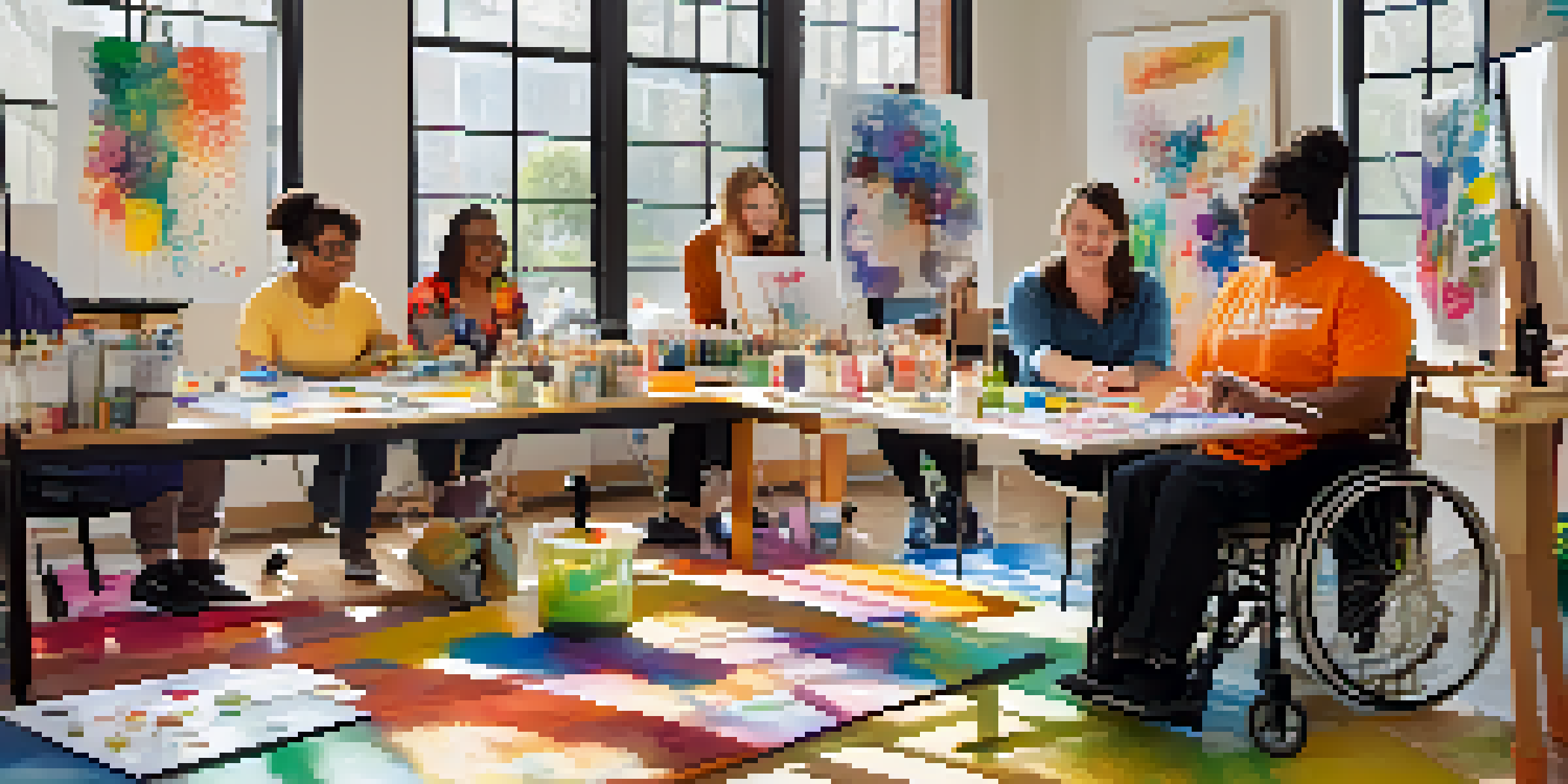The Role of Authentic Voices in Disability Representation

Understanding Disability Representation in Media
Disability representation in media is essential for fostering understanding and empathy. It involves showcasing the diverse experiences of individuals with disabilities, moving beyond stereotypes and clichés. This representation can significantly impact public perception, shaping how society views and interacts with people who have disabilities. By providing a platform for authentic voices, media can contribute to a more inclusive narrative.
Diversity is being invited to the party; inclusion is being asked to dance.
Historically, disabled characters have often been portrayed through a narrow lens, focusing on their limitations rather than their full humanity. This skewed representation can lead to misconceptions and reinforce societal stigma. Authentic voices challenge these narratives, offering a more nuanced and accurate portrayal of the disability experience. As audiences become more aware of these stories, they can develop a deeper understanding of the challenges and triumphs faced by individuals with disabilities.
The rise of social media has amplified the importance of authentic voices in disability representation. Platforms like Instagram and TikTok allow individuals with disabilities to share their stories directly, bypassing traditional media gatekeepers. This democratization of storytelling not only empowers disabled individuals but also enriches the broader cultural conversation about disability. Authentic voices from the disability community can foster connection, understanding, and ultimately, change.
The Impact of Authentic Voices on Perception
Authentic voices play a critical role in shaping public perception of disability. When people hear real stories from individuals with disabilities, it humanizes their experiences and challenges preconceived notions. For instance, a person sharing their journey with a visible disability can help others understand the daily realities they face, breaking down barriers of ignorance and bias. This shift in perception is vital for fostering a more inclusive society.

Moreover, authentic representation can inspire and empower both disabled and non-disabled individuals. When people see someone like themselves represented in media, it validates their experiences and encourages them to share their stories. This ripple effect can lead to greater advocacy for disability rights and a push for more inclusive policies. The more authentic voices are heard, the more society can learn and grow.
Education is Key to Inclusion
Teaching about diverse disability experiences cultivates understanding and empathy from a young age.
An example of this can be seen in the rise of disability influencers on social media. These individuals share their lives, challenges, and triumphs, creating a relatable and authentic narrative. This visibility helps to normalize disability in everyday conversations and can inspire change within organizations and communities. By amplifying these voices, we pave the way for a more equitable future.
Challenges Faced by Authentic Voices
While the importance of authentic voices in disability representation is clear, these voices often face significant challenges. One major hurdle is the lack of opportunities for disabled individuals to share their stories in mainstream media. Despite the growing demand for diverse narratives, many disabled creators struggle to find platforms that will elevate their voices. This exclusion perpetuates the cycle of misrepresentation and limits the broader understanding of disability.
The stories we tell literally make the world, so let’s tell better stories.
Additionally, when authentic voices do make it into mainstream media, they may be subject to scrutiny and criticism. Disabled individuals often experience pressure to represent their entire community, which can be an overwhelming responsibility. This can lead to feelings of inadequacy and the fear of misrepresenting their peers. It's crucial for media outlets to recognize the diversity within the disabled community and allow for varied perspectives.
Another challenge is the risk of tokenism, where disabled individuals are included in media merely for appearances without genuine representation. This can undermine the authenticity of their voices and lead to further marginalization. It's essential for creators and consumers alike to advocate for meaningful representation that uplifts authentic voices, ensuring that their stories are told with respect and integrity.
The Role of Storytelling in Authentic Representation
Storytelling is a powerful tool in amplifying authentic voices and enhancing disability representation. When individuals share their personal narratives, they provide insight into their thoughts, feelings, and experiences. This storytelling creates an emotional connection with the audience, fostering empathy and understanding. It allows people to see disabilities not just as challenges but as part of a rich, diverse human experience.
Effective storytelling can take many forms, from written articles and podcasts to visual media like documentaries and films. Each medium offers unique ways to convey the complexities of living with a disability. For example, a documentary can capture the daily experiences of a disabled individual, bringing viewers along on their journey. This immersive approach allows audiences to engage with the narrative on a deeper level, leading to greater awareness and appreciation.
Authentic Voices Foster Empathy
Genuine representations of disability in media help humanize experiences and challenge societal misconceptions.
Moreover, storytelling can empower disabled individuals to reclaim their narratives. By sharing their experiences in their own words, they can challenge societal misconceptions and advocate for change. This shift in narrative ownership is crucial for authentic representation, as it allows disabled voices to take center stage. Ultimately, storytelling is a vital component in the fight for accurate and respectful disability representation.
The Importance of Collaboration in Representation
Collaboration is key when it comes to authentic disability representation. Media creators and disabled individuals must work together to ensure that stories are told accurately and respectfully. By involving disabled voices in the creative process, filmmakers, writers, and producers can gain valuable insights that lead to more authentic narratives. This partnership can result in content that resonates more deeply with audiences and reflects the true diversity of the disability experience.
For example, hiring disabled actors to portray disabled characters not only enhances authenticity but also provides opportunities for those within the community. When creators prioritize collaboration, they can avoid perpetuating stereotypes and instead showcase the richness of disabled lives. This approach creates a more inclusive media landscape that benefits everyone involved.
Moreover, collaboration extends beyond just individual stories; it can also foster a sense of community among disabled individuals. By working together on projects, disabled creators can share their experiences, learn from one another, and build a supportive network. This collaboration can lead to increased visibility and recognition for authentic voices, ultimately driving change in the industry.
The Role of Education in Fostering Authentic Voices
Education plays a crucial role in fostering authentic voices within the disability community. By educating individuals about the diverse experiences of people with disabilities, we can cultivate empathy and understanding from a young age. This foundational knowledge can help dismantle stereotypes and promote a more inclusive mindset. Schools, organizations, and communities must prioritize disability education to pave the way for future generations of authentic voices.
Workshops, seminars, and training programs can provide valuable resources for both disabled and non-disabled individuals. These educational initiatives can focus on the importance of representation, the impact of language on perceptions, and the significance of sharing personal narratives. By equipping people with the tools to understand and appreciate disability, we can foster a culture that values authentic voices.
Collaboration Enhances Representation
Working together with disabled individuals ensures accurate and respectful storytelling in media.
Additionally, integrating disability studies into academic curricula can encourage students to explore various perspectives and experiences. This approach can help break down barriers and promote a more inclusive society. Ultimately, education is a powerful means of amplifying authentic voices and ensuring that diverse narratives are respected and celebrated.
The Future of Authentic Voices in Disability Representation
Looking ahead, the future of authentic voices in disability representation appears promising, yet it requires ongoing advocacy and commitment. As society becomes more aware of the importance of diversity and inclusion, there is a growing demand for authentic narratives. Media creators, organizations, and audiences must prioritize these voices to ensure that the representation of disability continues to evolve positively. By doing so, we can create a more equitable media landscape.
Technological advancements also offer exciting opportunities for authentic representation. Virtual reality, augmented reality, and other innovative platforms can provide immersive experiences that allow audiences to engage with disability narratives in new ways. These technologies can help bridge gaps in understanding and foster empathy, making the experiences of disabled individuals more accessible to everyone.

Ultimately, the future of disability representation hinges on the continued empowerment of authentic voices. By supporting disabled creators, advocating for inclusive policies, and prioritizing education, we can work towards a media landscape that reflects the richness and diversity of the disability experience. Together, we can ensure that every voice is heard, valued, and respected.